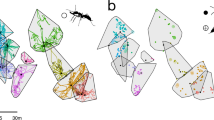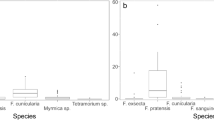Summary
Intraspecific interference competition in the harvester ant,Messor aciculatus, was studied. Colonies of this species were found not to have territories. Some nests were located very close to each other, and the foraging areas of the neighbors usually overlapped. Even though the frequency with which alien and resident ants met was very high in the vicinity of the nest entrances, aggressive interactions between them rarely occurred. However, when hostile workers encountered each other, they exhibited a kind of ritualized combat and the winner ejected, but did not injure the loser. If any aliens entered the nest, some of them were pulled out, mainly by the residents.
Aliens roaming near a neighbor's nest entrance ferociously attacked the residents carrying seeds in their mandibles and robbed them. On other occasions, aliens entered the nest and stole the collected seed. Although seed robbing and stealing occurred among neighboring colonies, there were remarkable differences in the frequency of their occurrence. The results of field observations and experiments suggest the existence of a dominance order among the neighbors. In one instance, extermination of an inferior colony by its neighbor was observed. The raider colony transferred the stored seeds from the nest of the inferior colony to its own and deposited the larvae and workers some distance away from the nest.
The influence of ritualized combat and food robbing on colony activities, and the ecological significance of this interference behavior in terms of spatial distribution and temporal persistence of the nest sites, is discussed.
Similar content being viewed by others
References
Abe, T., 1971. On the food sharing among four species of ants in a sandy grassland I. Food and foraging behavior (in Japanese with English summary).Jap. J. Ecol. 20:219–230.
Adams, E. S., 1990. Boundary disputes in the territorial antAzteca trigona: effects of asymmetries in colony size.Anim. Behav. 39:321–328.
Baroni Urbani. C., 1979. Territoriality in social insects. In: The Social Insects, H. R. Hermann, ed. Academic Press, N.Y., pp 91–120.
Czechowski, W., 1984. Tournaments and raids inLasius niger (L.) (Hymenoptera, Formicidae).Ann. Zool Warszawa 38:81–91.
DeVita, J., 1979. Mechanisms of interference and foraging among colonies of the harvester antPogonomyrmex californicus in the Mojave desert.Ecology 60:729–737.
Dobrzański, J., 1966. Contribution to the ethology ofLeptothorax acervorum (Hymenoptera: Formicidae).Acta Biol. Exper. (Warsaw)26:71–78.
Ettershank, G. and J. A. Ettershank. 1982. Ritualized fighting in the meat antIridomyrmex purpureus (Smith) (Hymenoptera: Formicidae).J. Aust. Ent. Soc. 21:97–102.
Gordon, D. M., 1986. The dynamics of the daily round of the harvester ant colony (Pogonomyrmex barbatus).Anim. Behav. 34:1402–1419.
Gordon, D. M., 1989a. Dynamics of task switching in harvester ants.Anim. Behav. 38:194–204.
Gordon, D. M., 1989b. Ants distinguish neighbors from strangers.Oecologia 81:198–200.
Gordon, D. M., 1991. Behavioral flexibility and the foraging ecology of seed-eating ants.American Naturalist 138:379–411.
Gordon, D. M., 1992. How colony growth affects forager intrusion between neighboring harvester ant colonies.Behav. Ecol. Sociobiol. 31:417–427.
Harrison, J. S. and J. B. Gentry, 1981. Foraging pattern, colony distribution, and foraging range of the Florida harvester ant,Pogonomyrmex badius.Ecology 62:1467–1473.
Hölldobler, B., 1976a. Tournaments and Slavery in a Desert Ant.Science 192:912–914.
Hölldobler, B., 1976b. Recruitment behavior, Home range orientation and territoriality in harvester ants,Pogonomyrmex. Behav.Ecol. Sociobiol. 1:3–44.
Hölldobler, B., 1981. Foraging and spatiotemporal territories in the honey antMyrmecocystus mimicus Wheeler (Hymenoptera: Formicidae).Behav. Ecol. Sociobiol. 9:301–314.
Hölldobler, B. and C. J. Lumsden, 1980. Territorial strategies in ants.Science 210:732–739.
Hölldobler, B., 1983. Territorial behavior in the Green tree ants (Oecophylla smaragdina).Biotropical 15:241–250.
Hölldobler, B. and E. O. Wilson, 1990.The Ants. 732 pp. The Belknap press of Harvard Univ. press Cambridge, Massachusetts.
Janzen, D. H., 1967. Interaction of bull's-horn acacia (Acaciacornigera L.) with an ant inhabitant (Pseudomyrmexferruginea F. Smith) in eastern Mexico.Kansas Univ. Sci. Bull. 47:315–558.
Johnson, R. A., 1991. Learning, memory, and foraging efficiency-in two species of desert seed- harvester ants.Ecology 72:1408–1419.
Krebs, R. A. and S. W. Rissing, 1991. Preference for large foundress associations in the desert antMessorpergandei.Anim. Behav. 41:361–363.
Kubota, M., 1948. Observations on the habits ofMessor aciculatus Smith (in Japanese). ShinKontyu 1:226–230.
Le Moli, F. and S. Parmigiani, 1982. Intraspecific combat in the red wood ant (Formicalugubris, Zeit).Aggressive Behav. 8:145–148.
Le Moli, F., A. Mori, and S. Parmigiani, 1982. Agonistic behavior ofFormica rufa L. (Hymenopera Formicidae).Monitore zool. ital. (N. S.)16:325–331.
Le Moli, F. and A. Mori, 1986. The aggression test as a possible taxonomic tool in theFormica rufa group.Aggressive Behav. 12:93–102.
Levings, S. C. and J. F. A. Traniello, 1981. Territoriality, nest dispersion and community structure in ant.Psyche 88:265–319.
Mabelis, A. A., 1979. Wood ant war: the relationship between aggression and predation in the red wood ants (Formicapolyctena Först.).Neth. J. Zool. 29:451–620.
Onoyama, K. and T. Abe, 1982. Foraging behavior of the harvester antMessor aciculatus in relation to the amount and distribution of food.Jap. J. Ecol. 32:383–393.
Rissing, S. W., 1981. Foraging specializations of individual seed-harvester ants.Behav. Ecol. Sociobiol. 9:149–152.
Rissing, S. W. and G. B. Pollock, 1987. Queen aggression, pleometrotic advantage and brood raiding in the antVeromessor pergandei (Hymenoptera: Formicidae).Anim. Behav.35:975–981.
Author information
Authors and Affiliations
Rights and permissions
About this article
Cite this article
Yamaguchi, T. Intraspecific competition through food robbing in the harvester ant,Messor aciculatus (Fr. Smith), and its consequences on colony survival. Ins. Soc 42, 89–101 (1995). https://doi.org/10.1007/BF01245701
Received:
Revised:
Accepted:
Issue Date:
DOI: https://doi.org/10.1007/BF01245701




